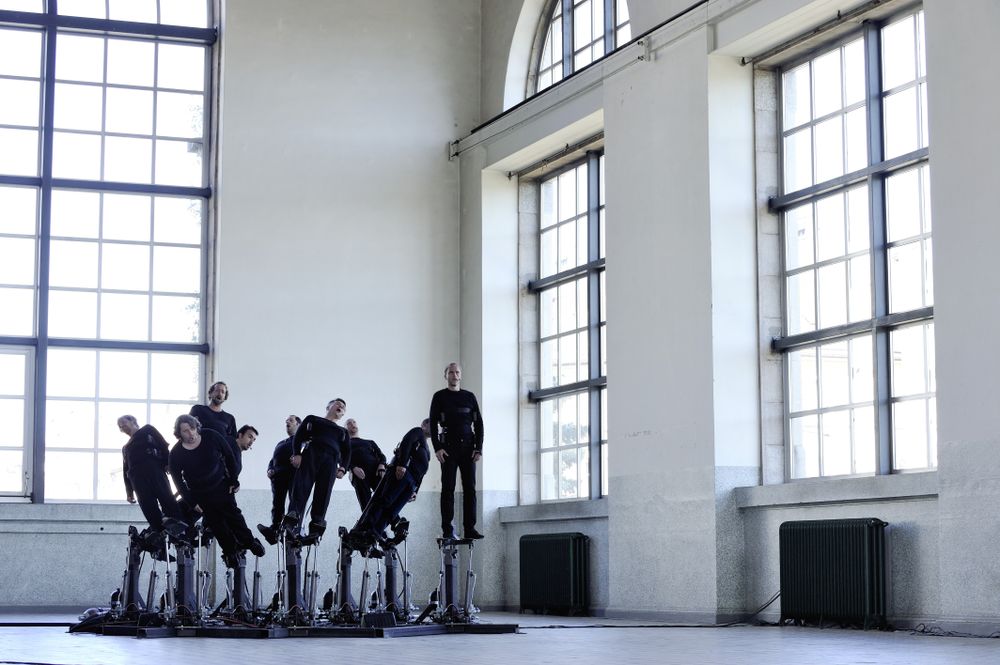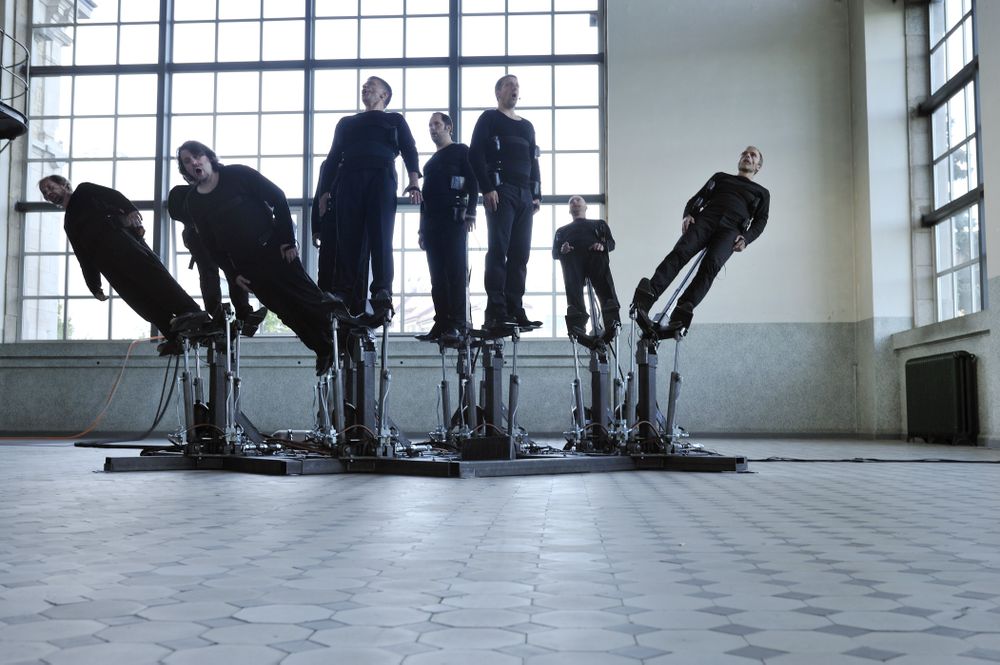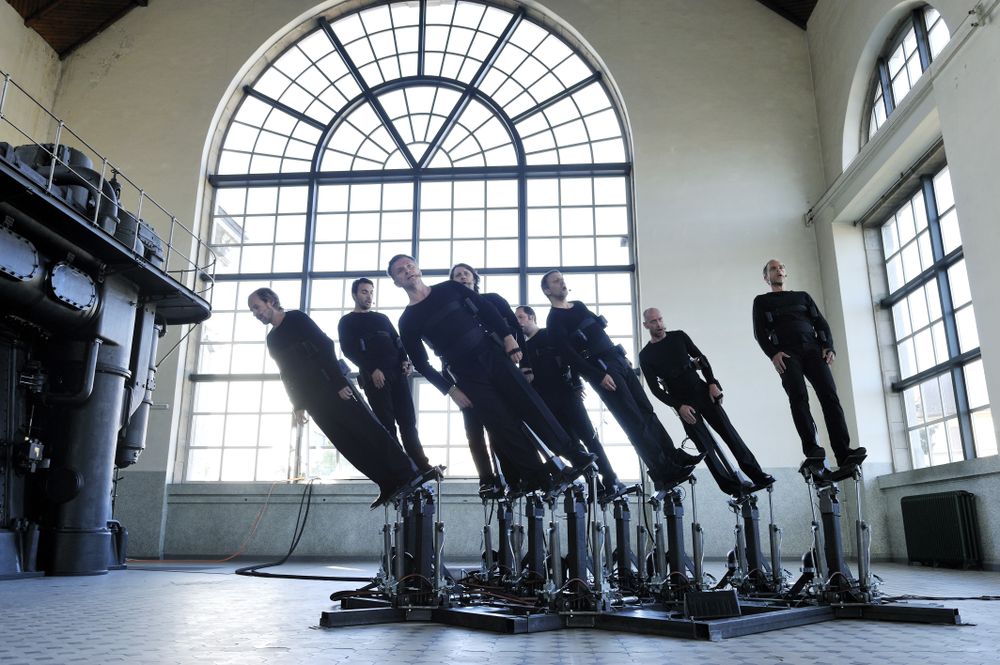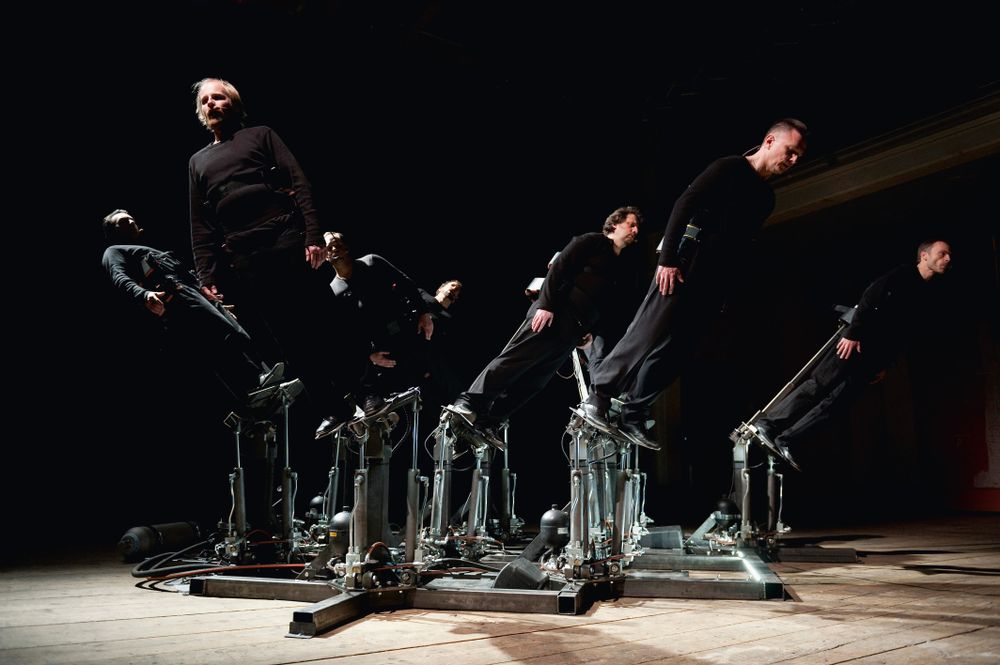ARS ELECTRONICA ARCHIVE - PRIX
Der Prix Ars Electronica Showcase ist eine Sammlung, innerhalb derer die Einreichungen der KünstlerInnen zum Prix seit 1987 durchsucht und gesichtet werden können. Zu den Gewinnerprojekten liegen umfangreiche Informationen und audiovisuelle Medien vor. ALLE weiteren Einreichungen sind mit den Basisdaten in Listenform recherchierbar.
Pendulum Choir
Cod.Act,
André Décosterd,
Michel Décosterd
(In alphabetischer Reihenfolge)
112260Original: Pendulum_Choir_video.mpg | 720 * 576px | 12m 31s | 549.0 MB

Original: Pendulum_Choir_1.jpg | 4256 * 2832px | 2.3 MB | Photo Pendulum Choir

Original: Pendulum_Choir_2.jpg | 4203 * 2797px | 2.1 MB | Photo Pendulum Choir

Original: Pendulum_Choir_3.jpg | 4256 * 2832px | 2.7 MB | Photo Pendulum Choir

Original: IA_130168_196429_AEC_PRX_2013_pendulum_choir_dunkel_1675207.jpg | 4256 * 2832px | 1.5 MB
_Pendulum Choir_ ist ein Chorstück für neun A-Capella-Stimmen und 18 hydraulische Zylinder. Die Sänger stehen auf Kipppodesten, die zusammen einen lebenden Klangkörper bilden. Dieser Körper drückt sich durch verschiedene physische Zustände aus. Seine Plastizität hängt mit seiner Sonorität zusammen. Diese pendelt zwischen abstrakten, repetitiven, lyrischen und narrativen Klängen. Die Körper und Stimmen der Sänger kämpfen und spielen mit der Schwerkraft. Sich aufeinander zu und voneinander weg neigend, schaffen sie subtile vokale Polyphonien. Oder sie geben, unterstützt von elektronischen Klängen, ihren Zusammenhalt auf und brechen in lyrische Höhenflüge aus oder verschränken sich in einem obsessiven, düsteren Ritual. Das Gesamte ist eine Reise vom Leben zum Tod in einer robotischen Allegorie, in der sich technische Komplexität und der Lyrismus bewegter Körper zu einem Werk mit prometheischen Akzenten vereinen.
2006 versuchten wir mit _ex pharao_ eine Neufassung von Arnold Schönbergs Oper _Moses und Aaron_. Sie nahm die Form eines Orchesterstücks an, bei dem das Publikum in Echtzeit Klang und dramaturgische Parameter modifizieren konnte. Die Modifikationen erfolgten mithilfe einer mechanischen Konstruktion. Der/die ZuhörerIn war zugleich Dirigent des Orchesters und eine der Figuren der Oper. Mit _Pendulum Choir_ führen wir unsere Recherche über mögliche Beziehungen und Interaktionen zwischen orchestraler Musik und Bewegung fort, diesmal im Bereich „a cappella“.
Die Idee, einen bewegten Chor zu schaffen, ergab sich im Rahmen unserer Forschung aus dem Bestreben, eine möglichst stimmige und natürliche Beziehung zwischen Bewegung und Klang herzustellen. Bei _Pendulum Choir_ unterwirft die mechanische Konstruktion die Sänger körperlichen Einschränkungen und wirkt sich damit auch auf deren Gesang aus. Auf diese Weise entstehen neue, unerwartete Klangqualitäten, ein plastisches Moment, das wir in die Partitur mit einbeziehen wollten. Ebenso wollten wir die Auswirkungen von Schwerkraft und Beschleunigung auf die Sänger einbeziehen, Phänomene, die zwar gut aus der Mechanik bekannt sind, aber in der Musik noch keine Berücksichtigung gefunden haben.
Die Idee eines Gebildes aus klingenden und bewegten menschlichen Körpern, das sich unter Einwirkung physischer Kräfte auf natürliche Weise verformt, erinnert an ein lebendes Organ – einen Muskel, der in Abhängigkeit von seinen Verformungen Klänge von sich gibt.
Um ein homogenes plastisches Musikstück zu schaffen, legten wir ihm das Bild einer Lunge zugrunde. Jeder Sänger ist ein Lungenbläschen. Die durch das Organ strömende Luft nimmt im Gesang der Sänger Klanggestalt an. Der Atem ist auch Thema des Stücks.
Die Verbindung zwischen den Sängerkörpern ist plastisch-elastisch. Die Bewegung des Chors stellt ständig den Zusammenklang und die Verdichtung der Stimmen infrage. Das Klangmaterial des Atems ist im Grunde abstrakt und repetitiv, kann aber auch als verbal und narrativ gesehen werden. Der Chor haucht den Atem aus und singt das Aushauchen zugleich. Er bewegt sich vom Leben zum Tod, schnaubt, ringt nach Luft, verliert das Gleichgewicht, während er vom Gefühl des letzten Atemzugs auf dem Weg zur Hölle berichtet. Dieser Teil beruht auf Gedichten von Vergil, Ovid und Horaz. Die Bewegungen verstärken die Erzählung. Das Werk entfaltet sich zwischen Abstraktion und Lyrismus.
2006 versuchten wir mit _ex pharao_ eine Neufassung von Arnold Schönbergs Oper _Moses und Aaron_. Sie nahm die Form eines Orchesterstücks an, bei dem das Publikum in Echtzeit Klang und dramaturgische Parameter modifizieren konnte. Die Modifikationen erfolgten mithilfe einer mechanischen Konstruktion. Der/die ZuhörerIn war zugleich Dirigent des Orchesters und eine der Figuren der Oper. Mit _Pendulum Choir_ führen wir unsere Recherche über mögliche Beziehungen und Interaktionen zwischen orchestraler Musik und Bewegung fort, diesmal im Bereich „a cappella“.
Die Idee, einen bewegten Chor zu schaffen, ergab sich im Rahmen unserer Forschung aus dem Bestreben, eine möglichst stimmige und natürliche Beziehung zwischen Bewegung und Klang herzustellen. Bei _Pendulum Choir_ unterwirft die mechanische Konstruktion die Sänger körperlichen Einschränkungen und wirkt sich damit auch auf deren Gesang aus. Auf diese Weise entstehen neue, unerwartete Klangqualitäten, ein plastisches Moment, das wir in die Partitur mit einbeziehen wollten. Ebenso wollten wir die Auswirkungen von Schwerkraft und Beschleunigung auf die Sänger einbeziehen, Phänomene, die zwar gut aus der Mechanik bekannt sind, aber in der Musik noch keine Berücksichtigung gefunden haben.
Die Idee eines Gebildes aus klingenden und bewegten menschlichen Körpern, das sich unter Einwirkung physischer Kräfte auf natürliche Weise verformt, erinnert an ein lebendes Organ – einen Muskel, der in Abhängigkeit von seinen Verformungen Klänge von sich gibt.
Um ein homogenes plastisches Musikstück zu schaffen, legten wir ihm das Bild einer Lunge zugrunde. Jeder Sänger ist ein Lungenbläschen. Die durch das Organ strömende Luft nimmt im Gesang der Sänger Klanggestalt an. Der Atem ist auch Thema des Stücks.
Die Verbindung zwischen den Sängerkörpern ist plastisch-elastisch. Die Bewegung des Chors stellt ständig den Zusammenklang und die Verdichtung der Stimmen infrage. Das Klangmaterial des Atems ist im Grunde abstrakt und repetitiv, kann aber auch als verbal und narrativ gesehen werden. Der Chor haucht den Atem aus und singt das Aushauchen zugleich. Er bewegt sich vom Leben zum Tod, schnaubt, ringt nach Luft, verliert das Gleichgewicht, während er vom Gefühl des letzten Atemzugs auf dem Weg zur Hölle berichtet. Dieser Teil beruht auf Gedichten von Vergil, Ovid und Horaz. Die Bewegungen verstärken die Erzählung. Das Werk entfaltet sich zwischen Abstraktion und Lyrismus.
Photos: Xavier Voirol
Michel Décosterd (CH), geb. 1969, arbeitete zunächst als Architekt in Berlin und Weimar (1994–96). Seit 1997 ist er im Bereich Bildhauerei und Architektur tätig und entwickelt und konstruiert Klangmaschinen.
André Décosterd (CH), geb. 1967, absolvierte 1984–88 eine Orgelbauerlehre. Seit 1997 arbeitet er als Musiker und Komponist. Er spezialisiert sich auf Programmierung von Musikapplikationen. Auseinandersetzung mit typisch zeitgenössischen Kompositionssystemen, insbesondere logarithmischer Komposition und Forschungen zur Mensch-Maschinen-Interaktion. Schreibt musikalische Werke für zeitgenössische Ensembles und fürs Theater und lehrt an der Ejma in Lausanne.
1997 gründeten Michel und André die Gruppe Cod.Act, die von Beginn an mit Jacques Décosterd (1936), einem aus der Industrie kommenden Computer- und Automatisierungstechniker, zusammenarbeitet.
André Décosterd (CH), geb. 1967, absolvierte 1984–88 eine Orgelbauerlehre. Seit 1997 arbeitet er als Musiker und Komponist. Er spezialisiert sich auf Programmierung von Musikapplikationen. Auseinandersetzung mit typisch zeitgenössischen Kompositionssystemen, insbesondere logarithmischer Komposition und Forschungen zur Mensch-Maschinen-Interaktion. Schreibt musikalische Werke für zeitgenössische Ensembles und fürs Theater und lehrt an der Ejma in Lausanne.
1997 gründeten Michel und André die Gruppe Cod.Act, die von Beginn an mit Jacques Décosterd (1936), einem aus der Industrie kommenden Computer- und Automatisierungstechniker, zusammenarbeitet.


